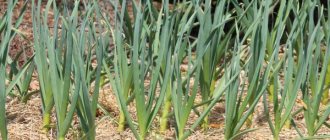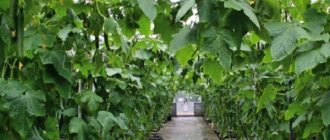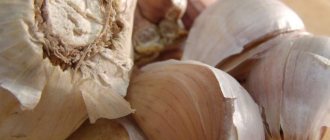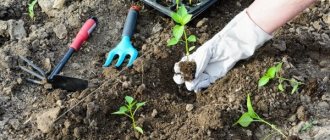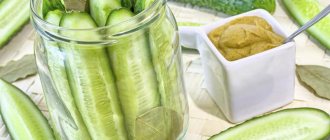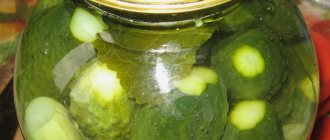Advantages and disadvantages of combined plantings
Bell pepper is a capricious vegetable and loves heat. That is why it is planted in greenhouses, but it also gets along well in open ground conditions. There is very little space indoors; the plants are in close proximity. Indoors are humid and diseases multiply quickly. It is important to prevent possible diseases. Crops that repel harmful insects and prevent the growth of bacteria are perfect for growing next to peppers.
You may be interested in:
Bell pepper seeds are the best varieties for open ground. Today, the market for garden crops amazes with its diversity. Pepper alone has about 2000 varieties,...Read more...
Gardeners have been mixing different crops for a long time. The advantages of this method:
- land is used sparingly;
- self-defense of plants;
- energy savings, less watering and fertilizing;
- different plants are grown at the same time;
- the taste of vegetables is noticeably improved.
Note!
The Bulgarian vegetable is called sweet. Different cultures significantly affect its taste.
Shifting harvests
Growing crops with different harvest dates in one bed is another option for joint planting. To make the most of the space of a small garden, increasing the yield per square meter, you can grow early-ripening and late-ripening crops together.
Pepper ripens quite late, and due to its heat-loving nature, it is planted in open ground in late spring and early summer. Therefore, in its garden bed, before planting seedlings, you can grow early ripening crops - green onions, radishes, peas or lettuce.
Growing crops with different harvest dates in one bed is another option for joint planting.
Neighborhood options
When using the method of joint planting, it is important to understand which vegetables can grow next to each other, and which should be at long distances. If you plant an unsuitable crop next to paprika, it may stop bearing fruit altogether.
You can plant next to bell pepper:
- Corn. If you plant it along the paprika, it will be protected from its direct sunlight. This has an adverse effect on the pepper harvest. However, it can protect sensitive vegetables from cold winds. To prevent corn from blocking direct sunlight, it should be planted on the north side.
- Eggplant and sweet vegetable belong to the same family. Therefore, they have similar growing requirements. For them, you need to observe timely watering and similar weather conditions. However, these points make caring for these plants easier.
- Cauliflower and white cabbage go well with bell peppers in a greenhouse. But you should take into account that cabbage requires a lot of moisture. It is best to plant them in nearby beds in open ground conditions. Cabbage with its large leaves will protect plants from the cold.
- It is not recommended to plant paprika and carrots together because of flies. The disease can spread to the “Bulgarian”. Carrots can be planted in the nearest garden bed, then they will get along peacefully.
- The proximity of pepper to zucchini is acceptable. However, the first one will darken the paprika with its leaves. Beans are like a neighbor. It enriches the soil with nitrogen and also provides protection to the plant from pests that do not tolerate legumes. Gardeners plant bush beans, considering them especially useful. Peas and legumes have an adverse effect.
- In open ground conditions, tomatoes and peppers can be friends. Tomatoes love a ventilated room, and peppers love warmth. They should not be placed in the same greenhouse.
- Onions and garlic are otherwise called plant healers. They take up minimal space and “help” to grow and bear fruit. Doctors secrete phytoncides that repel all kinds of pests and bacteria from the growing culture. It is best to plant them in the same bed with peppers.
Spicy herbs have similar properties. For non-self-pollinating pepper varieties, they help attract insects.
Note!
Basil, dill, thyme have a satisfactory effect. They have a large amount of phytoncides, which promote plant development, provide protection from pests, and resist the development of bacteria.
Even harmful weeds and flowers can benefit peppers. Dandelions, nettles, marigolds, and chamomiles contribute to the rapid ripening of vegetables. They protect against diseases, saturate the soil with necessary minerals and simplify the work of summer residents. In greenhouse conditions, they must be in a single copy, otherwise they will fill the entire space. Dandelions promote rapid ripening of fruits.
What goes well with bell pepper?
It is allowed to plant the following crops next to pepper:
May be interesting Pepper “Apricot Favorite”: juicy and bright Why the leaves of peppers turned white after planting in a greenhouse or open ground: prevention, treatment methods Pepper “Giant F1”: colorful and attractive
- basil, corn, eggplant;
- cabbage, carrots, zucchini, tomatoes;
- onions, garlic, thyme, marigolds;
- tansy, coriander, parsley, catnip, radish;
- nettle, chamomile, dandelions;
- spinach, lettuce.
Open and closed ground - all these vegetables and flowers are perfect for making friends with sweet peppers everywhere. They can grow either permanently or complement the beds. Such greenery helps young bushes stay in the shade under the scorching sun. Allows additional absorption of moisture after watering.
Some herbs promote early maturation of young plants by attracting pollinating insects. Fungal infections are killed at the root. Surprisingly, corn helps sweet peppers stay in the shade. Thanks to its large, voluminous bushes, it provides an excellent barrier against unwanted cold. But it does not completely block out the sun.
Weeds, after decomposition, feed the soil with their fertilizers and humus, so gardeners leave several weeds nearby. Peppers should be planted in this way with a distance of 40 cm between each other, and supplemented with other crops in the rows. Some plants can repel harmful insects, such as carrots.
What not to grow with sweet peppers
Many vegetable crops coexist peacefully with the “Bulgarian”, but there are also those that under no circumstances should be planted next to peppers. Under the influence of ill-wishers, the plant’s yield will decrease, and the death of the entire plant may occur.
Unfavorable neighbors:
- Bulgarian bushes cannot be planted together with potatoes. There will be a fight for nutrients between vegetables, potatoes will win. It forms large tubers. A small amount of beneficial minerals negatively affects vegetables. These crops have similar problems and will be susceptible to insect pests and fungal diseases.
- You cannot plant beets and peppers together. There is a constant battle for minerals, in which beets take away most of the nutrients and sunlight.
You may be interested in:
The main differences between seedlings of sweet and bitter peppers If after planting peppers the names of the varieties are lost, then seedlings of bitter and sweet varieties can be distinguished by their appearance...Read more...
Other relatives of pepper have similar requirements for growing conditions. They could be neighbors, but there is one “but”. For example, a spicy and a sweet vegetable can cross-pollinate. The entire harvest may be bitter to some extent. It is best to plant pepper varieties in different corners of the plot!
Attention!
There are plants that promote the development of peppers in open areas of soil, but interfere with them in a greenhouse. It is necessary to know the nuances of plant distribution in different conditions.
A few more options for what to plant with beets in the same bed:
In one bed, alternate rows of onions, turnips and beets. Or plant onions in the center of the bed, and rows of beets on the sides.
In the cucumber bed, plant rows of beets between the rows of cucumbers.
Now that you know what to plant with your beets in the same bed, don't plant them alone. After all, in joint sowing you will get a much larger and healthier harvest!
Even more interesting articles on the site:
- Growing beets: how to grow beets correctly
- How to preserve carrots for the winter: 4 main rules
- Selecting the best varieties of carrots for the Moscow region
- What to plant after pumpkin next year
Good neighbors
Any farmer who knows well the needs of certain plants can calculate suitable neighbors for a particular crop, but this is a lot of work and takes a lot of time. It is much easier to rely on conclusions already made by experts earlier. They name several crops for which sorrel will be a good neighbor (as they are for it). These include:
- berry bushes (black and red currants, gooseberries, raspberries). It is worth noting here that sorrel prevents the raspberry tree from growing, thereby helping the grower solve one of the most difficult problems that arise when growing this garden crop;
- garden strawberries. Strawberries do not get along well with raspberries and other garden crops. By placing sorrel between them, you will not allow the berries to have a bad influence on each other. It will become a kind of barrier to insect pests and diseases, without being harmed by it;
- representatives of the cruciferous family. These include almost all types of cabbage, radishes, radishes, and some types of lettuce;
- carrots, celery and other representatives of the umbrella family;
- pumpkin, zucchini, celery;
- mint (or lemon balm). This is the only herbaceous spice plant that gets along well with sorrel.
A good idea would be to place sorrel bushes between garden and vegetable crops.
Unlucky neighbors
There are not many plants with which sorrel is at war, and they are easy to remember. This:
- tomatoes;
- legumes;
- spicy plants (except mint).
It is better to place the above crops away from sorrel so that they do not negatively affect each other.
Sorrel is one of the most unpretentious plants, but even its garden neighbors must be chosen with care. Knowing the subtleties of cultural proximity, you will reap a rich harvest of both the most sour greens and other crops growing next to them.
- Vitamins at hand: planting sorrel and caring for it in open ground
Is it possible to plant cucumbers after cucumbers?
The rules for optimal planting do not provide for growing the same crop in the same place for several seasons in a row. These standards also apply to cucumbers.
- In the open ground
- Is it possible to grow cucumbers and tomatoes in the same greenhouse: video
- The subtleties of growing cucumbers: video
Therefore, it is best to plant this vegetable after the recommended predecessors. But if this is not possible, then you need to take care of more thorough soil preparation.
Let’s say if you have one greenhouse in which you are forced to plant cucumbers year after year, then at the end of the season, after harvesting, plant green manure. And in the spring you will need to add compost to the soil.
What to plant after cucumbers next year?
Cucumbers have a shallow root system, therefore, they deplete the topmost layer of soil. According to the rules of crop rotation, root crops and crops with stronger roots can be planted in their place.
In the open ground
In open ground, it is best to plant root vegetables such as radishes, turnips, beets, carrots, and potatoes. Tomatoes, celery, parsley, onions, and garlic are also guaranteed to produce a good harvest.
By planting legumes after the pimpled vegetable, you can increase soil fertility. Beans, beans, and peas will saturate the soil with nutrients and prepare it for planting: peppers, potatoes, tomatoes, zucchini, lettuce, onions and corn.
In the greenhouse
In a greenhouse, the soil is depleted even more than in open beds. Cucumbers take almost all the nitrogen from the soil, and in return they release phenolic compounds. Therefore, vegetables with roots going deep into the soil are suitable for planting after cucumbers. These are crops such as:
- parsley;
- celery;
- parsnip;
- early potatoes;
- eggplant;
- tomatoes;
- pepper.
Harmful substances remaining in the top layer of soil after growing cucumbers will not be dangerous for them. To minimize the harm caused by secretions from cucumber roots, it is best to burn the tops immediately after harvesting the cucumbers. The lashes are also not suitable for compost.
You can further improve the condition of the soil by sowing white mustard seeds.
This plant is used as green manure, digging up green shoots with soil. All this must be done before the onset of frost. Then the soil is covered with black film and left until spring.
Vegetable crop rotation table
Then why plant cucumbers for next year?
According to crop rotation standards, cucumbers are returned to their original place 3-4 years after cultivation. This rule applies to both greenhouses and open ground. Some crops deplete the soil, while others generously give it nutrients. Since cucumbers need a nitrogen-rich substrate, they are planted after those crops that leave this chemical in the soil.
In the open ground
Ideal predecessors for cucumbers in open ground are beans, beans and peas. They generously saturate the earth with nitrogen. Moreover, the stems are not thrown away after growing legumes. They are crushed with a shovel and dug up along with the ground. Over the winter, the plant residues will rot, and you will get excellent nutritious soil.
Onions and garlic can also be considered as precursors for cucumbers. After them, the bed is suitable for almost any vegetables. Due to their bactericidal properties, these crops cleanse the soil well of harmful microflora.
Good predecessors would be: potatoes, carrots and beets, since when they were grown, the top layer of soil rested, retaining useful substances.
In the greenhouse
Cucumbers can be planted after cabbage. This rule applies to all types of cruciferous vegetables. Before cucumbers, you can grow kohlrabi, red and white cabbage. If early varieties of cabbage were used, then cucumbers can be planted after it in the current season.
Growing cruciferous vegetables helps loosen the soil in the garden bed.
Suitable predecessors for cucumbers are nightshades. These crops tend to disinfect the soil. Therefore, feel free to plant cucumbers after tomatoes and peppers, if they were not sick during cultivation.
Are cucumbers planted after tomatoes and vice versa?
Until now, disputes among summer residents have not subsided over whether it is possible to plant cucumbers after tomatoes. Experts give an affirmative answer to this.
Tomatoes are good predecessors for cucumbers. This principle also works in the opposite direction. Especially often, these two crops are planted after each other in a greenhouse.
Cucumbers are a cucurbit crop, and tomatoes are a nightshade crop. Therefore, they do not have common diseases. Cucumbers love fresh organic matter, it is vital for them. After a year, the rotted fertilizer will ideally saturate the soil for growing tomatoes.
After which you can’t plant cucumbers
Considering that you should not plant plants of the same type one after another, representatives of the pumpkin family can be considered undesirable predecessors for cucumbers. This list includes:
- pumpkin;
- zucchini;
- squash;
- zucchini;
- watermelons;
- melons
Why are these recommendations given?
All these crops have common diseases and pests, so larvae and various bacteria that are dangerous for cucumbers may remain in the soil. Another reason is forced liming of the soil. If you carry it out for several seasons in a row, this will contribute to excessive accumulation of alkali, which will prevent the planted crop from developing normally.
All pumpkin plants actively suck microelements from the soil for their development, greatly depleting the soil, which does not at all contribute to good yield. Cucumbers will not develop well in such a bed, unlike weeds.
What not to plant after cucumbers
After cucumbers, cucumbers and other crops from the pumpkin family are not planted in the same place. If you neglect this rule, you will not get a good harvest.
It is recommended to return cucumbers to their original place no earlier than after 3-4 years. Cucumber beds are not suitable for planting cabbage either. When grown, the root system of cucumbers releases colins into the soil - substances that pose a danger to all pumpkin crops. Therefore, it is better to avoid planting pumpkins, zucchini, melons, and watermelons in a cucumber bed.
The best neighbors - what to plant nearby?
Crops successfully located in the neighborhood will help each other grow, produce substances necessary for neighbors, and jointly repel pests. Therefore, it is important to select vegetables in the garden so that they do not compete for a “place in the sun”, but interact successfully. It is not recommended to plant cucumbers near potato, salad and herb plantings. The exception is dill.
The proximity to tomatoes is controversial, although some grow them in the same greenhouse.
- Firstly, these vegetables have different microclimate requirements.
- Secondly, as tomatoes grow, they will inhibit cucumber plants.
- They also have differences in watering.
Radishes, beets, corn, and peas get along well next to cucumbers. Due to their agricultural technology, these crops do not compete with cucumbers for nutrients.
Eggplants will be good neighbors for cucumbers. They can be grown side by side both in open ground and in a greenhouse. Growing cucumbers and peppers at the same time is also quite acceptable. It is only necessary to observe the conditions under which the cucumber vines will not obscure the pepper, so take into account the direction of growth of the lashes. The proximity to zucchini can also be called good. Just make sure that their leaves do not drown out the cucumber specimens.
A suitable neighbor for cucumbers is sunflower. The powerful stems of this plant provide support for vines with green foliage.
Is it possible to grow cucumbers and tomatoes in the same greenhouse: video
What soil and growing conditions do cucumbers need?
Cucumbers love fertile soil. This should not be forgotten when growing them both in open ground and in a greenhouse. It is best if the soil composition is loamy or sandy loam. Heavy and acidic soils are not suitable for cucumbers. The acid reaction must be neutral or slightly alkaline. The optimal indicator would be a pH of 7.
Soil acidity can be determined by using litmus paper or by observing weed growth. If horsetail, plantain, horse sorrel and heather grow on the site, it means that the acidity is high and it needs to be reduced artificially.
You don’t need to do anything if you encounter weeds such as wheatgrass, clover, common chamomile, coltsfoot, and field bindweed. These plants are an indicator of weak soil acidity. Such land is quite suitable for growing cucumbers. The beds are prepared in the fall.
Acidic soil is limed using ash, lime, and dolomite flour. For low-acid soil, alkaline liquid fertilizers are used. In spring, the surface of the soil is dug up deeply, after which humus is added. Then the bed is watered abundantly and covered with film for 2-3 days. It doesn’t matter whether you are going to sow seeds or plant seedlings - the bed is prepared after the threat of frost has passed.
Helpful advice! It is recommended to grow cucumbers in raised beds. In this case, the harvest will be significantly greater.
7 days after preparation, you can plant cucumbers.
The subtleties of growing cucumbers: video
Please note that cucumbers are a crop that requires crop rotation and it is better to strictly follow agrotechnical rules. If you follow all the recommendations, you will be able to avoid problems with the incidence of this crop and harvest a good harvest of green pimply cucumbers, which you can happily eat fresh and use for preparing preparations for the winter.
Correct placement in an open area
On an open plot of land, the “Bulgarian” takes root with many crops that have phytoncidal properties and a specific smell. The aroma provides protection from insects. Such a neighborhood is possible in the form of mixed beds. A certain number of plants are planted in the garden bed and simultaneously processed. Various plants are planted between the rows.
The culture needs support and protection from the wind. Spicy herbs will help with this. You can plant a little:
- thyme;
- basilica;
- dill.
You may be interested in:
Bell pepper - planting seedlings and care in open ground and greenhouses Bell pepper is a fairly unpretentious crop that grows well in the southern climate. When growing a plant…Read more…
Carrots, eggplants and zucchini are similar in care. They interact with each other on an open piece of land. Caring for them will save the gardener's energy. Some ornamental plants stimulate the rapid ripening of fruits. For example, nettle and chamomile will allow pepper to develop faster. However, it is necessary to monitor the spread of these weeds and carry out weeding in a timely manner.
Crop rotation
Bell peppers should be planted after crops that did not require constant digging and abundant fertilizer. Growing in a plot that was enriched not in the previous season, but the year before, will be the easiest. It is enough to add a little organic matter into the holes when planting to get a rich harvest. Sweet varietal peppers place their roots close to the surface, and require strong support to secure the bush. Therefore, good predecessors would be:
- carrot;
- tomatoes;
- cabbage;
- beet;
- zucchini.
On a note!
The seating plan needs to be changed annually, even if the area is very small. This is the best prevention of soil depletion. High soil moisture and fertility are important for pepper. Therefore, any plant that required frequent and abundant watering, and had deep roots that did not deplete the upper layers of the soil, would be a good predecessor. In general, remembering the rules of crop rotation is not difficult: if the crop has the same type of bush and growth format as peppers, then you should not swap these particular plantings and vice versa.
The culture has few unwanted predecessors. For example, in beds with any potatoes, in place of eggplants or pumpkins, the crop cannot be planted even after abundant fertilizer. It is not advisable to change the planting positions of peppers, physalis, eggplants and ornamental or aromatic tobacco. Any beans are a neutral precursor, so you need to focus on the condition of the soil.
After peppers are planted in the garden, it is difficult to achieve a good harvest, especially when growing large vegetable crops. The plant literally dries out the upper layers of the soil and absorbs all the useful elements. It is better to plan to plant species with deep roots and edible green parts in this place. This can be perennial asparagus, celery, leeks, or any leaf lettuce. You won’t be able to get a lot of zucchini, cabbage, carrots or beets in such a bed.
Correct placement in the greenhouse
Since there is little space in the greenhouse and high humidity, neighbors must be selected carefully. The development of diseases in a humid environment is rapid. Gardeners try to plan out the greenhouse area as much as possible and prevent disease infections.
Note!
Planting onions is allowed in a greenhouse. Spicy herbs can be planted not only in open areas, but also in greenhouses.
It is not advisable to plant crops of the same family:
- Tomatoes and eggplants suffer from the same diseases as peppers.
- Infections are easily transferred from one bush to another.
- Poor quality ventilation threatens the loss of the entire crop.
Decorative crops (chamomiles, dandelions, nasturtiums) have a good effect on vegetable plantings and increase their productivity. Legumes, peas and beans in greenhouses are quite dangerous. Beets and certain varieties of cabbage negatively affect crop development. Fennel is an aggressive plant. Its aromatic substances are detrimental to many crops, including pepper.
Best neighbors in a greenhouse
When planting vegetables indoors, gardeners try to use the space as efficiently as possible. When choosing neighbors in the beds, the rules of crop rotation and the peculiarities of growing individual plant crops are taken into account:
- Eggplants will be a good companion for Bulgarian sweet varieties. You just need to take into account that eggplants develop better at a temperature of 22-28°C. Therefore, it is advisable to plant pepper bushes closer to the door or near the window. Plants are distributed in separate beds, since eggplants consume more water;
- Neighborhood with onions and carrots is allowed. Thick carrot tops prevent the soil from drying out, and the root vegetables release some useful substances. Onions naturally disinfect the soil and air in the greenhouse;
- Spicy herbs (coriander, parsley, thyme) develop well in a greenhouse and do not harm the bushes. On the contrary, basil repels some insects (aphids, whiteflies) that can harm bell peppers and prevents the spread of powdery mildew. Marjoram attracts bees, which is very useful for pollinating vegetables in closed ground conditions;
- gets along well with cucumbers, since both vegetables are heat-loving and require plenty of soil moisture. But when planting them, you need to take into account the high need of pepper for lighting, so the tall stems of cucumbers should not block it from the light. It should be taken into account that the bushes of sweet Bulgarian varieties love drier air, so cucumber plantings are located in the center of the greenhouse;
- Close proximity of cabbage is allowed. White and cauliflower varieties deserve preference.
Bulgarian sweet varieties have good compatibility with zucchini. Both species require abundant irrigation during the period of fruit ripening.
Expert opinion
Stanislav Pavlovich
Gardener with 17 years of experience and our expert
Ask a Question
Advice! When planning a greenhouse site, you need to take into account that zucchini plants form a voluminous spreading bush, so they require more space.
Precursor vegetable
It is advisable to grow vegetables in different beds every year. Plants can be grown in the same soil for up to three years. Pepper relatives should also not be planted in the same place. It is advisable to change the location every year.
It is not recommended to plant after peppers:
- cucumbers;
- zucchini;
- pumpkin crops.
They will finally absorb all the nutrients from the soil. The earth will be depleted. However, varieties of other vegetables will easily replenish the balance.
Choosing a place and soil
Before planting peppers, it is imperative to choose the right place and appropriate soil. Pepper is a heat-loving plant, so the area must be sunny and at the same time free from drafts. Temperature changes have a very negative impact on the growth, development and, as a result, on the yield of hot peppers. In hot weather, and especially at its peak, plants need to create shade, since the sun's rays can cause burns on the foliage.
For growing peppers, the ideal place is a greenhouse or greenhouse rather than open ground. Since it is in the greenhouse and greenhouse that the regular levels of temperature and humidity are maintained, which are so important for the development of peppers, even minimal temperature changes can slow down growth. It is impossible to create such conditions on open ground, but at the same time, with proper and proper care, you can grow a fruitful crop on it.
The soil for hot peppers should be loose, fertile, moist and non-acidic. Do not allow water to stagnate or become waterlogged - the roots may rot. If the soil is acidic, it needs to be “deacidified”; the most popular means for this is dolomite flour.
The area must be dug up and fertilized before planting.
Unlucky neighbors
When finding out who the plant is friends with, it is important to identify its “enemies”, with whom compatibility is negative, which will not only reduce the yield, but can also lead to the death of the plants. All the gardener’s efforts will be in vain.
Among the plants that peppers should not be planted next to is fennel. It is very aggressive, and the aromatic substances it releases can destroy the plantings of many crops, including sweet peppers.
The beet seedlings will be the first to take their “place in the sun”, taking not only most of the light, but also nutrients - such a proximity is unfavorable for both plants, but the pepper will be the first to lose.
Among the varieties of cabbage, there are species that are incompatible with pepper - kohlrabi and Brussels sprouts, which compete for nutrients.
It is unacceptable to plant sweet peppers next to hot ones. This will lead to cross-pollination of plants, as a result, sweet varieties will become bitter, the fruits will decrease, and the seeds obtained in the future will produce a new variety with sharp, bitter fruits - something between sweet and hot peppers. It is better if these varieties are located at a considerable distance from each other, preventing the combination of pollen.
It is not recommended to plant it next to potato plantings. These plants suffer from similar diseases, so their compatibility can lead to the rapid spread of diseases. In addition, the bushes formed by potatoes take up a lot of space, limiting the space for peppers.
Unfavorable neighbors for bell peppers are beans and peas. Although these crops enrich the soil with nitrogen and loosen it, when planted next to pepper, they suppress it. In addition, the peas are looking for support on which they could twine, and the seedlings standing nearby are well suited for this. As a result, the pepper may simply break or be “smothered” by the legume crop.
Features of growing pepper
Pepper, like any vegetable, has its own growing characteristics. The crop should be planted no earlier than March. The vegetable is grown only through seedlings, since the seeds take a long time to germinate. But in any case, they should immediately fall into the moist soil of the box. The seeds must be placed at a distance of 1-2 cm between them.
You need to sprinkle a small amount of compost on the seeds, and then cover them with glass and newspapers to keep the soil from drying out. Every day you need to change the sides of the glass by turning it over. Before seed germination, the temperature in the greenhouse should be at least 24°.
Pepper grown in protected soil requires fertilizer. Plant picking can be carried out if 2-3 petals are formed. When the crop sprouts reach 20-27 cm, they should be transplanted into separate containers and placed throughout the greenhouse. Pots with sprouted seeds should not be nearby. The distance between them should be 45 cm. After this, the young peppers need to be watered and fed with liquid fertilizer.
It is worth noting that transplanting seedlings into heated greenhouse beds should be carried out in March, and without heating - no earlier than April. Only seedlings that are at least 55 days old can be planted in the soil. During this period, flower buds begin to form on the plants.
Peppers should be planted in the ground at the depth at which they grew in containers. This is a specific “whim” of a vegetable compared to all nightshades.
When growing peppers in a greenhouse, you need to care for them in the same way as in open ground. The bushes must be watered and fertilized with insecticides. It is necessary to plant peppers in special pots, as this increases the yield.
Pepper requires careful and careful care. Maintaining the distance between crop sprouts and the depth of planting are the main components of proper cultivation of vegetables in a greenhouse.
Only by properly growing seedlings can you get a high-quality and rich harvest. In a greenhouse, you can artificially create favorable conditions for the development of any crop, including pepper.
Soil acidity
If the soil in the greenhouse is highly acidic, then it is necessary to use dolomite flour in a proportion of 100 g per square meter. It is very simple to use - scatter the flour over the surface of the ground over the entire area of the pepper beds. When distributed evenly, dolomite flour not only levels out acidity, but also creates an invisible film that retains moisture in the soil, preventing the upper layers from drying out.
Application of dolomite flour
Advice. If you do not have a special device or indicator strips that determine the acidity of the soil, you can resort to the traditional method.
Conduct some kind of chemical experiment. You will need a teaspoon of soil (do not take it from the very surface, dig a little deeper), it must be placed on a flat surface (preferably black) and watered with vinegar (9%). The results should be interpreted as follows:
- if a lot of foam forms, the soil environment is predominantly alkaline;
- if foaming is moderate, the soil is balanced;
- if there is no foaming, the soil is acidic.
Such a check must be carried out before each planting of plants, especially sensitive ones such as sweet bell peppers.
